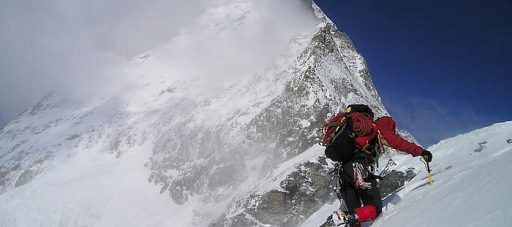Climbing the career ladder can feel a lot like trekking up a tall mountain. From afar, the path looks smooth and the ascent seems easily manageable. But as you draw nearer, the terrain gets rocky and each step presents new challenges. Before you know it, you’ve lost sight of the summit. While a literal mountain presents real physical barriers, the obstacles in a career are often self-imposed. With some thoughtful preparation, an adaptable mindset and a willingness to seek help when needed, you can create a strategic plan to reach new heights.
The View from Basecamp
When looking up at a towering peak, it’s tempting to underestimate the difficulty of scaling it. The same goes for envisioning a dream career years or decades into the future. At the start of your professional journey, success can seem just within reach if you set your sights on a goal and start climbing. But a smooth path from point A to point B rarely unfolds in reality. Unexpected obstacles arise, plans must flex and shift, and progress happens in fits and starts.
Before attempting to summit a major peak, experienced climbers spend time understanding the terrain and planning multiple routes. Your career ascent requires the same level of diligence. Rather than charging forward blindly, thoughtfully assess your strengths, knowledge and experience. Carefully consider which “summit” aligns with your values and vision for a fulfilling life. And map out a few alternative paths that utilize your capabilities.
Take Stock of Your Gear
Seasoned mountaineers would never attempt to scale El Capitan or Denali without gathering the proper gear. So before charting your course up the career mountain, take stock of your personal talent, skills, education and know-how. These tools won’t just assist your climb – they’ll often dictate which paths are accessible to you.
Spend time reflecting on your natural aptitudes, knowledge areas and specialized abilities developed from past experiences. What skills could set you apart from others? What unique perspectives do you bring? These attributes lay the foundation for determining viable routes to the summit. They enable you to bring value to teams and organizations.
Beyond your capabilities, also understand where you gain energy and purpose. Reflect on what projects excite you over the long term. The summit you choose should align with your interests and motivations at a core level. Otherwise, your enthusiasm is likely to wane when challenges arise.
Lastly, think long-term when assessing desired outcomes. Rather than focusing on job titles and prestige, envision your life 10, 20 or 30 years out. What legacy do you want to leave? Visualize scenarios where you look back feeling genuinely fulfilled by meaningful work.
Choose Your Summit Carefully
Your ultimate career fulfillment hangs heavily on the summit you choose to pursue. But a single “dream job” rarely exists. Personal aspirations and market realities shift over time. Priorities that move you today may not motivate you forever.
Rather than declaring a fixed destination, define criteria for what constitutes success to you. Focus less on prescribed roles and more on long-standing values. For instance, if creativity and innovation spark your passion, seek opportunities to incorporate those elements rather than limiting your search to specific industries.
As your journey progresses, new appealing summits will emerge based on changing vantage points. What beckons you now may not align with who you become and what you want years down the road. Building flexibility into your ascent strategy enables you to adapt when those milestones appear.
Leave room to modify the endpoint while still progressing intentionally towards higher ground. Following a meandering path doesn’t necessarily lead off course if you use your guiding principles as a compass.
Plotting Multiple Routes

Facing an enormous mountain, all the possible paths blend together at first glance. But upon closer inspection, distinct routes appear with varying degrees of difficulty. Trails might wind gradually up on ridges or scramble directly towards rocky cliffs. Seasoned climbers carefully assess all options before deciding on their course.
Your career journey requires this same diligence in evaluating pathways ahead of time. The daily demands of work often obscure long-term possibilities until suddenly an obstacle looms ahead. By mapping out alternative routes while you still have perspective, you give yourself the flexibility to adjust when circumstances change.
Plan A: Blaze the Ideal Trail
Your Primary Plan A reflects the best course you can envision given current information. You develop this path based on your capabilities and the opportunities directly in front of you. Follow this route as far as momentum carries you upwards. At times the climbing may feel effortless. You gain elevation quickly as everything clicks into place.
But even the most promising trails have twists and obstacles. Unexpected barriers might force detours or backtracking when Plan A stalls. Rather than clinging rigidly to a failing direction, refer to your backup options.
Plan B: Clear a New Trail
By outlining a contingency Plan B, you prepare for situations when Plan A no longer proves viable. This secondary route relies on similar strengths and capabilities, but through an alternate pathway.
For example, Plan A might launch you up the corporate ladder within a certain industry. When opportunities flatten, pivot into Plan B by taking a leadership role at a smaller company or specialized division focused more tightly on your skills.
Or if you gain altitude quickly on the startup trail, Plan B could involve leveraging your experience to consult entrepreneurs or perhaps build a new venture yourself.
Plan C: Scramble to a Different Peak
Sometimes an entirely unfamiliar landscape calls your name. Maybe after years progressing across certain terrain, a hidden valley captures your attention on the horizon. When the urge strikes to stray from familiar ground, reference your Plan C for charting a course to new summits.
This route capitalizes on transferrable abilities while allowing you to reinvent the trajectory. Rather than starting from basecamp again, you retain hard-won wisdom that accelerates your ascent.
For instance, lawyers often reach partner status before realizing their passion lies with mentoring young public defenders rather than billable hours. Teachers sometimes pivot into curriculum development roles. Engineers may launch a niche publishing company geared for their specialty.
Your next mountain takes shape once you open your perspective to all the possibilities your existing skills enable. Reflect on what “summit” allows you to continue doing activities you love while introducing new challenges.
Plan D: Seek Shelter When Necessary
Sometimes in life, things just don’t go according to plan. Chaos descends without warning; sudden storms blast every trail. Chilling winds and swirling snow obscure your ability even to see the next step.
In these scenarios, attempting to forge ahead often proves futile or even dangerous. Until conditions improve, the smartest mountaineers hunker down in protective shelter. They conserve physical resources and emotional resolve until the tempest passes.
Don’t hesitate to enact a Plan D by finding a stable environment that sustains you through upheaval. Working in a role unrelated to your ambitions does NOT equate abandoning your dreams. A day job simply funds your ability to regroup and regain perspective once the storm clouds part.
Protecting your basic wellbeing – through steady income, health insurance, etc – often allows the space needed to recoup motivation. Eventually, clearer skies reveal open trails where once only fog and sleet raged. Patience pays substantial dividends for those who wait out storms from a secure vantage point.
Navigating Inevitable Challenges

Even the most prepared, strategic climb includes twists and surprises that test your planning. Mishaps, changing conditions and self-doubt challenge your mental resilience. But several reliable tools can help you navigate obstacles along the way.
Pace Yourself According to Seasons
On a skyward trek of decades, maintaining speed and momentum always proves impossible. Human experience follows cycles of hardship and triumph. Season-long drought may ravage early gains. Extended storms can erode steep slopes built hastily during fair weather spurts.
Embrace the natural rhythms of progress inherent to any long journey. When momentum surges, make the most of opportunity tailwinds propelling your ascent. But also temper the pace to lay stable foundations anchored against future storms.
Conversely, uphill movement slows to a crawl when battered by harsh conditions. Still, forward motion grinds on until winds subside and the terrain clears. Even slow and incremental gains keep you poised for opportune progression when favorable conditions return.
Seek Shelter from Regular Storms
Weather patterns vary over days, seasons and years. But one constant rules every climate zone – storms WILL arise, often when least expected. mapping your ascent ahead, identifies potential protective sites in advance. Then when visibility drops suddenly, you can quickly shelter rather than panicking in dangerous conditions.
Career tempest manifest in numerous forms – economic downturns, company restructuring, project failures, interpersonal conflicts. Assessing your industry landscape regularly allows you to anticipate risks spots for turmoil. Have contingent plans mapped for redirecting roles or organizations if needed when skies darken.
Use Signposts to Orient Your Position
Whiteout conditions frequently disorient climbers on exposed terrain, obscuring every recognizable landmark. Without visual cues signaling location,steps lead nowhere fast despite diligent effort. But tapping into other sensory guides – sound, touch – redirects movement back on course.
Similar confusing spans will undoubtedly arise during your career. Heading gazing fixates on a title or responsibility long since passed from view. Ambiguous signs make every path look equally untraveled. Lacking concrete evidence of progress breeds frustration.
But allowing metrics and validation from superiors alone to dictate your worth proves foolish. In foggy moments, reference your own signposts planted early in the journey to confirm alignment with internal compasses. Return to the touchstone of WHY you set out on this ascent. Listen for resonance with those motivations. Use that continued harmony, not outside opinions, as your orienting force.
Find Your Sherpa Tribe
Even solo summits like Everest always occur within a web of support. Experienced sherpas prepare routes, establish camps, ferry supplies and guide struggling climbers. Tribes unite behind those daring great heights, invested in their collective success.
Career ascents demand this same safety net of mentorship, encouragement and direction. Seek wisdom from those a few steps ahead who understand the hardships looming. Allow colleagues walking parallel trails to motivate and inspire through camaraderie. And lift up emerging climbers in return.
Silicon Valley exemplifies this “pay it forward” ethic, with seasoned professionals actively grooming up-and-coming talent. But supportive career tribes exist everywhere. Conferences, industry networks, online forums and local Meetups all provide connection points.
Changing Course Mid-Climb
Striving towards a summit for years breeds stubborn determination to finish the ascent regardless of costs. Even when skies darken and winds howl, we fix our gaze downwards while struggling on. After investing so much sweat and grit into climbing this ONE mountain, starting fresh feels unimaginable.
But realizing a chosen peak no longer aligns with emerging priorities takes wisdom and courage. At times the healthiest path involves charting an entirely new course across the valley. Redirecting leverage hard-won skills to accelerate an alternate ascent. With the right mindset, you traverse to greener pastures rather than retreating down familiar slopes.
Beware the Sunk Cost Fallacy
both hikers and career builders often fall victim to the sunk cost fallacy, throwing additional resources at a poor investment simply attempting to earn back prior effort. But future losses never justify past expenditures.
When evaluating a potential pivot, reflect honestly on WHY aspects now feel misaligned. Consider only whether continuing the present climb serves your CURRENT well-being and life aspirations. Disregard time already spent and external opinions anchoring your choice.
If aspirations once spurring your uphill battle now ring hollow, perhaps a new vista now calls with revitalized purpose. Permitting your “someday” dream to evolve comes with maturity and self-awareness.
Embrace Transferrable Skills
Changing course rarely requires starting from absolute zero. In fact, your existing knowledge often kickstarts rapid acceleration up new slopes. Pivoting careers simply leverages relevant expertise into new applications.
Hybrid technology-meets-creative roles populate a growing landscape once deemed incompatible. Healthcare professionals pursue passion projects developing medical devices or wellness startups. Finance analysts become rogue spreadsheet enthusiasts helping companies track triple bottom lines.
Rather than siloing your skills and identity, recognize vertical industries thirst for multifaceted talent. Business challenges permeate every environment in modern connectivity. Bring hard-won wisdom into emerging spaces ripe for vision. Blend, don’t bifurcate, your abilities.
Value Acquired Wisdoms
Inching towards cresting one peak fuels priceless learning about the broader terrain. The climbing journey itself forges grit and resilience absent from those transported suddenly to summits by helicopter. By conquering fears, sharpening instincts and awakening courage along your trail, you equip yourself for leadership supporting future explorers.
Every detour and backtrack builds neural pathways and sinew soon put towards surmounting greater obstacles ahead. Progress shapes capability even more than pure talent though both contribute value. The compounding dividends of applying past lessons accelerate future triumphs.
So rather than mourning the supposed “lost progress” of an altered ascent, honor acquired wisdoms readying you for new horizons. Trust that efforts redirecting towards a purposeful North Star rarely retrace South. Each upward step lays foundations for continents undiscovered.
Final Ascent Tips
- Plan dynamic routes accounting for unforeseeable conditions that alter landscapes over decades. Summit locations shift.
- Master fundamental skills like risk assessment, conflict management and communication that enable flexibility when industries evolve. Specialization has short half-life.
- Take each leg deliberately while allowing destination to crystallize gradually through growth and discovery over the ascent.
- Rest/refuel responsibly to nurture resilience through stressful obstacles and long horizons. Marathon mentality prevents burnout.
The freedom to shape our life’s work as we envision remains one of humanity’s greatest privileges. Plotting multiple courses up career peaks allows responding fluidly when views transform. New realms emerge at each hard-won height. So climb on intrepid explorer. Greater wonders await than you can possibly fathom now gazing upward. The true summit reveals itself through purposeful pursuit more than arrival.







